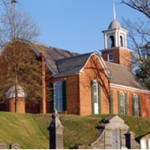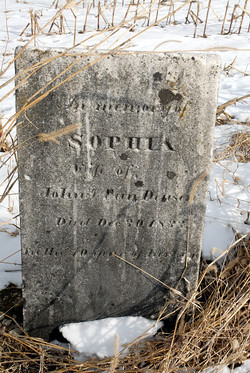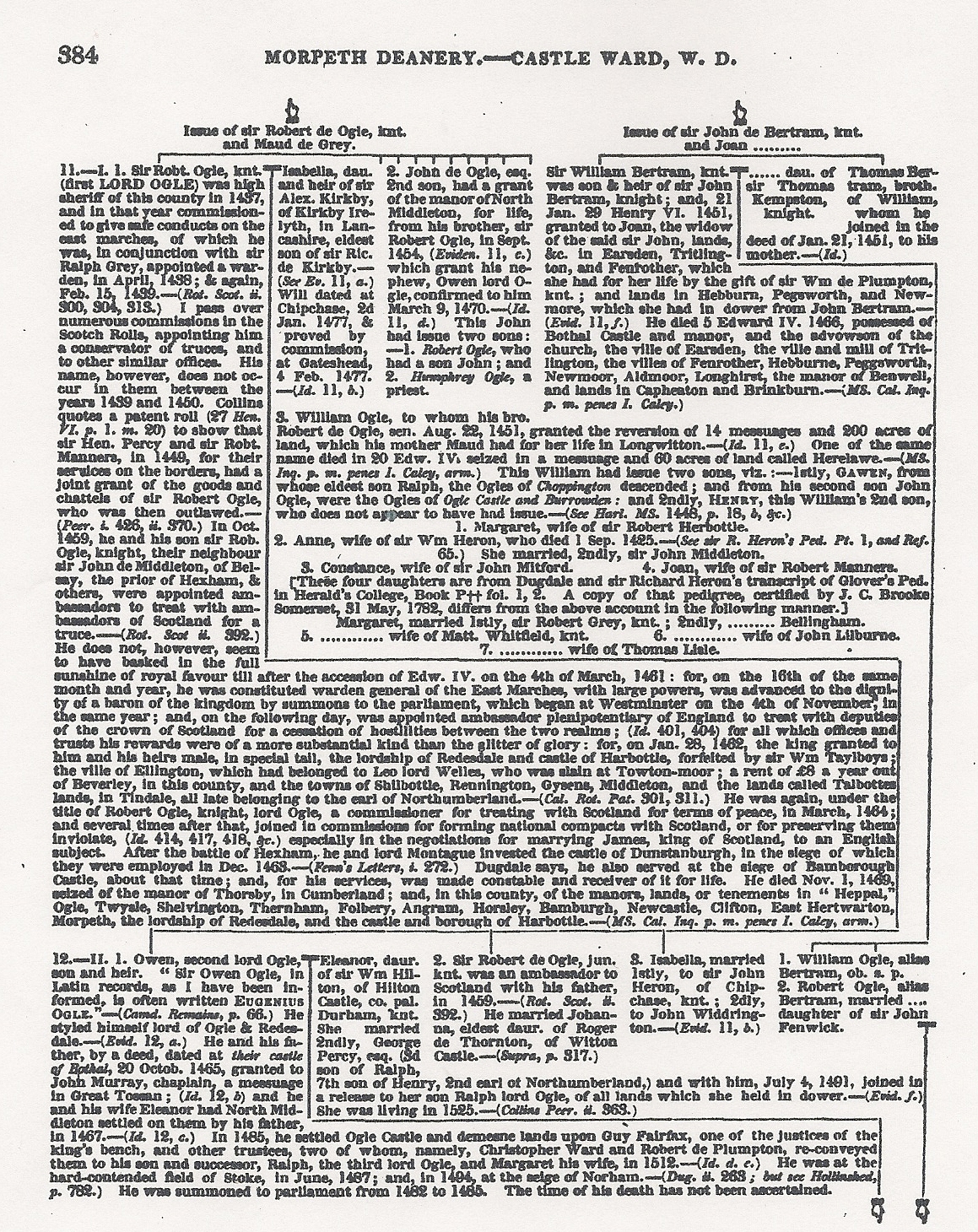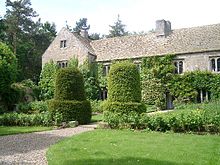Sir Robert Ogle (abt. 1370-1436), later to become knight, Baron of Ogle and Hepple was born about 1370 in Northumberland, England. His parents were Sir Robert Ogle and Joan Heton.
Robert Ogle married Matilda/Maud Grey in May 1399.
She is considered a daughter of Sir Thomas Grey of Heton by Joan Mowbray, daughter and heir of John, Lord Mowbray (d.1382). Some authorities state that her father was the son of Sir Thomas Grey and Joan Mowbray and that he married Alice Neville, daughter of the earl of Westmoreland.
The question of the identity of Maud’s parents remains debated. While there is no consensus across various pedigrees, Maud Grey’s parents link directly back to the Mowbray family (through Elizabeth Seagrave and John Mowbray), thus supporting a descendancy from King Edward I. What is consistent is that Maud’s father was a Grey (either Thomas, Robert or John) and her mother or grandmother was a Mowbray (either Joan or Catherine).
Perhaps one of the most trust worthy references is The History of the Parliament considered “one of the most ambitious, authoritative and well-researched projects in British history.” The History of Parliament documents Maud‘s parents as Sir Thomas Grey of Heaton in Wark (1359-1400) and Joan Mowbray. This parentage is also noted in the “The Plantagenet Ancestry: A study in colonial and medieval families” (see references).
A Wikipedia citation on Ogle family notes:
“The Ogle line has royal descendants from King Edward I of England and King Philippe III of France through Maud Grey, daughter of Jane De Mowbray and Sir Thomas Gray of Warke; who married ca. 21 May 1399, Sir Robert Ogle, Knight, Warden of Roxborough Castle, son of Sir Robert Ogle, Knight, of Ogle and Bothal Castles. (Cp. X, 28-29) (Ref: Living Descendants of Blood Royal, volume 5, 266).”

Ruins of Roxburgh Castle where Robert Ogle was Warden
He was known as Sheriff of Northumberland & Northamshire, Constable of Berwick-upon-Tweed, Northam, Roxburgh, & Wark Castles.
Robert Ogle married Maud Grey. There is no consensus across various pedigrees of the identity of Maud Grey‘s parents except that they all link directly link back to the Mowbray family (through Elizabeth Seagrave and John Mowbray) thus substantiating a descendancy from King Edward I. What is consistent is that her father was a Grey (either Thomas, Robert or John) and her mother or grandmother was a Mowbray (either Joan or Catherine).
Perhaps the most trust worthy reference is The History of the Parliament considered “one of the most ambitious, authoritative and well-researched projects in British history.” The History of Parliament documents Maud‘s parents as Sir Thomas Grey of Heaton in Wark (1359-1400) and Joan Mowbray. In addition, this parentage is also noted in the “The Plantagenet Ancestry.”
A Wikipedia citation on Ogle family notes:
“The Ogle line has royal descendants from King Edward I of England and King Philippe III of France through Maud Grey, daughter of Jane De Mowbray and Sir Thomas Gray of Warke; who married ca. 21 May 1399, Sir Robert Ogle, Knight, Warden of Roxborough Castle, son of Sir Robert Ogle, Knight, of Ogle and Bothal Castles. (Cp. X, 28-29) (Ref: Living Descendants of Blood Royal, volume 5, 266).”
OUT The Bordley Pedigree identifies the parents of Maud Grey as Sir Thomas Grey of Heton who was beheaded in 1415 and Alice Neville, daughter of Sir Ralph Neville. Sir Thomas Grey of Heton/Heaton was the son of Catherine Mowbray linking Robert Ogle and Maud Grey’s offspring to King Edward I.
CHECK THIS “The History of Northumberland” pedigree below connects Maud Grey to the Mowbrays by noting that her father was Robert Grey while her mother was Alice Neville, the daughter of Ralph Neville and Catherine Mowbray.
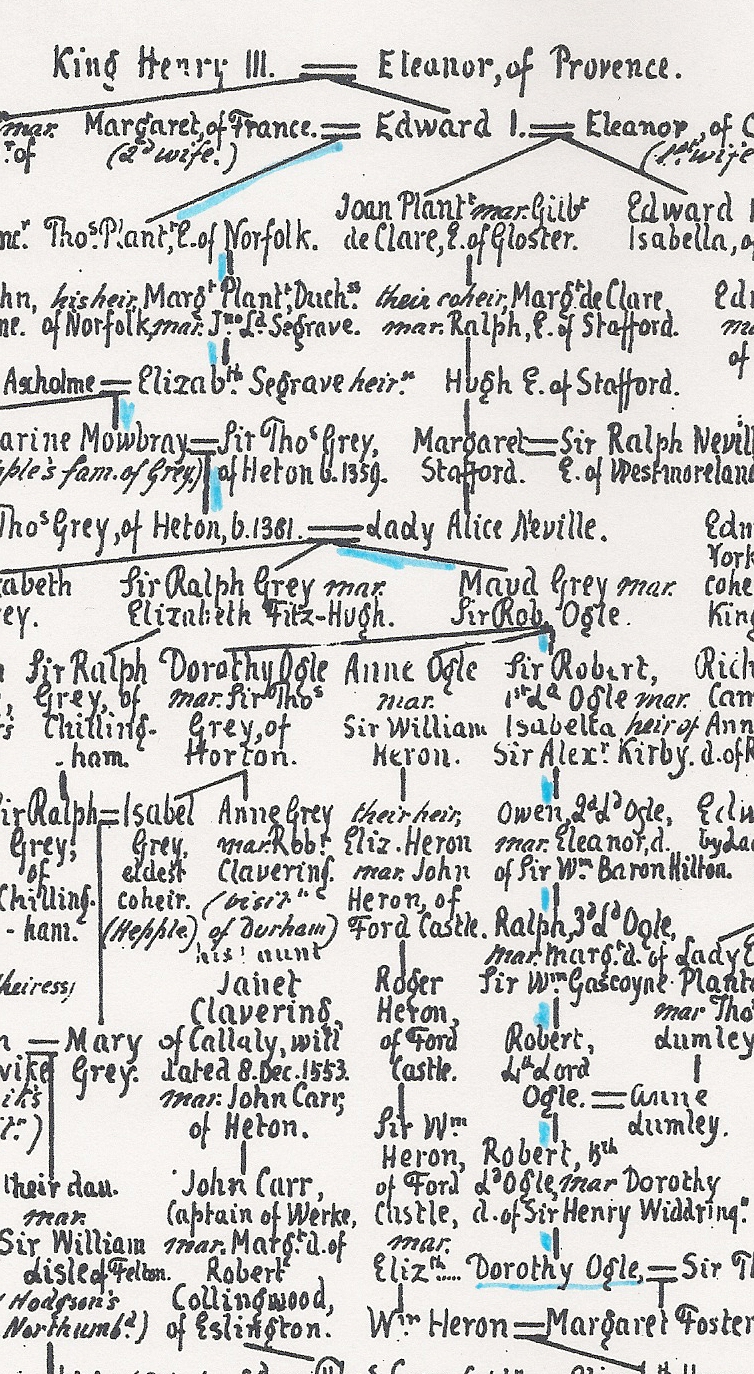
Royal Pedigree from Genealogy of the descendants of the Prichards, formerly lords of Llanover … By Thomas Gregory Smart
The problem with this pedigree by Smart is found in its chronology. If Maud’s grandfather was Thomas Grey born 1359 and her father was Thomas Grey born 1381, her father would have only been 18 years old at time of his daughter Maud’s marriage to Robert Ogle. More likely is that her father was Thomas Grey born 1359 and age 40 at the time of his daughter’s marriage.
While the identity of Maud‘s parents is not consistent, there does seems to be a consistency that her father was a Grey and her mother or grandmother a Mowbray.
The History of Parliament cites the following in Robert Ogle’s biography:
Sir Robert Ogle the elder (c. 1353-1409) played a leading part in affairs on the Scottish border, and in 1393 he became constable of Roxburgh castle. Not surprisingly, then, he was able to arrange an extremely advantageous marriage for his eldest son, Robert Ogle (1370-1436)… who, in May 1399, became the husband of Sir Thomas Gray’s daughter, Maud. Through her mother, Joan, a daughter of John, Lord Mowbray (d. bef. 1368), and sister of Thomas Mowbray, duke of Norfolk (d.1399), Maud was related to several members of the English baronage, while her brother, William Gray, was destined to become bishop of London in 1426, and later, in 1431, of Lincoln. At the time of their marriage, the young couple received from Sir Thomas an estate in Lowick.
Robert Ogle‘s life included documented battles, triumphs, service, and strong will. The most striking illustration is the adversarial relationship between Robert and his brother John, who adopted his mother’s name Bertram. The History of Parliament lists each of them as one of its members and the biographies of Robert Ogle and John Bertram detail their lifelong sibling conflict regarding inheritance.
Robert Ogle‘s (c.1370-1436) father Sir Robert Ogle (c. 1353-1409) was growing old and wished to set his affairs in order. From his aged mother Ellen Bertram (d.1403), Sir Robert had recently inherited a life interest in the manor and castle of Bothal.
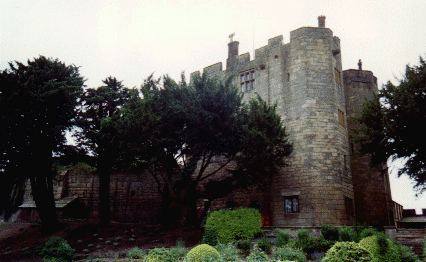
Bothal Castle
First the reversion and then the life interest itself were settled upon his second son, John Bertram, to whom he paid an annual rent of £200 for use of the property, until, in 1409, the young man himself took up residence there. John, who had already adopted the name of Bertram, was clearly his father’s favorite, for he, rather than Robert, was chosen to execute the elderly knight’s will.
Another brother, named Alexander, had already been promised land and tenements in Ingram, Angrave and Tynemouth, but he died young without issue. Although Robert now stood to inherit Alexander’s share, along with all the rest of the family estates, comprising the manors and castles of Ogle, Hepple, Newstead, Sewingshields, Flotterton and North Middleton, the manors of Ellingham, Saltwick, Nedderton, Larbottle and Shilvington, and other holdings in over 30 Northumbrian villages, he still bitterly resented the loss of Bothal, which he determined to seize for himself at the first opportunity.
When Robert’s father died on 31 Oct. 1409, he had wished to be buried in a splendid and costly tomb at Whalton, but an outbreak of plague made necessary his immediate interment at Hexham. Robert Ogle had, no doubt, already begun mustering a private army (which was said to number over 200 strong and to include a contingent of Scots), for within a matter of hours, before the funeral had taken place, he was on the march to Bothal.
Despite protests from Sampson Hardyng and Sir John Widdrington, Robert proceeded to invest the castle, to evict his brother John Bertram, to make off with goods worth an estimated £200 and to destroy other property and crops valued at the same amount.
Brother John Bertram’s strongly worded protest to the Parliament of 1410 elicited a prompt response, which led to the restoration of the castle and Robert Ogle’s appearance, under heavy sureties, before the royal council. Even so, Robert was far too powerful a figure to suffer disgrace for long. Not only did he gain custody of his inheritance as soon as an assignment of dower had been made to his widowed mother, but he also obtained probate of his father’s will, having assumed without legal title his brother’s role as executor.
His relations with Sir John Widdrington appear to have improved, too, since in February 1410 the two men briefly shared between them a valuable cargo of merchandise and Scottish prisoners which had been wrecked off the Northumbrian coast, but which was eventually confiscated by the Crown. Given, moreover, that he was knighted at about this time and sent off on an embassy to Scotland, Sir Robert Ogle can hardly be said to have lost any of his influence at Court.
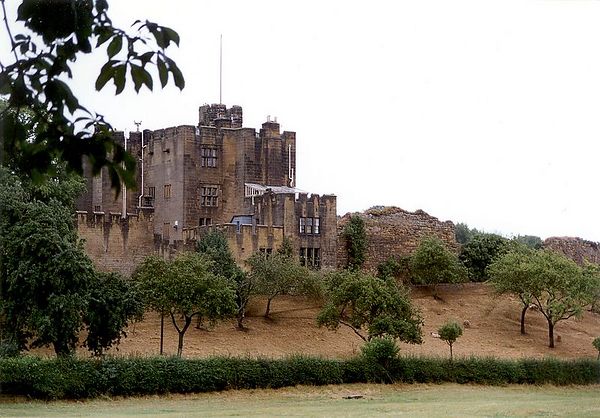
Bothal Castle
 In 5th Henry V, Robert Ogle was constituted sheriff of Northumberland. In the 2nd Henry V, he was joined with Henry, Earl of Northumberland and other great men in those parts, to conduct James, King of Scotland, from Durham into his own realm. That prince, being then, upon hostages given, enlarged after an imprisonment of some years.
In 5th Henry V, Robert Ogle was constituted sheriff of Northumberland. In the 2nd Henry V, he was joined with Henry, Earl of Northumberland and other great men in those parts, to conduct James, King of Scotland, from Durham into his own realm. That prince, being then, upon hostages given, enlarged after an imprisonment of some years.
Robert
On
In 1401, Robert Ogle was summoned with his father to attend the King’s Council at Westminster.
The Scots were defeated at Nesbit moor in 1402 and three months later they invaded under the earl of Douglas and the duke of Albany with 10,000 men. On returning laden with plunder they were intercepted by the earl of Northumberland and his son, Hotspur, and routed at Humbledon Hill.
Robert Ogle must have been a man of great zeal and energy, for as early as of February 2, 1403, he, as Robert de Ogle, son of Sir Robert Ogle, knight, was appointed constable at Norham Castle,
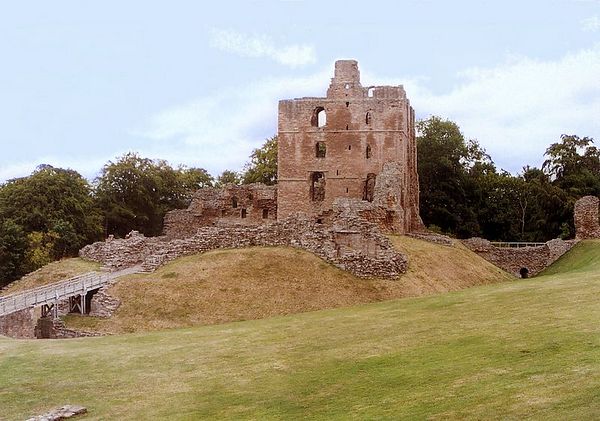
Norham Castle
and justice, seneschal, sheriff and escheator in Norhamshire and Islandshire for seven years. He was on September 6, 1403 appointed to these offices for life and is mentioned as constable and escheator a few years later and appointed justice of assize on July 28, 1407, and constable again in 1410.
In 1409/10, Robert Ogle and others had in their hands the prisoners and goods of a Flemish ship wrecked at Warkworth. His brother, John Bertram, by virtue of the remainder in the entail and by a grant made by his father, having taken and being in peaceable possession of the castle and manor of Bothal, this Robert Ogle, on the day after his father’s death, at a late hour some time near midnight, on All Hallows day, went with 200 armed men at arms and archers, partly soldiers and partly Scotchmen, all enemies of the king and in a warlike manner invested the castle of Bothal with escales, pavises, hurdises and other ordnance of war and after besieging it for four days and more, got possession of it by forcible entry, though John de Widdrington and Sampson Harding, two justices of the peace, had charged the besiegers to desist from the assault.
Whereupon John Bertram, on the 13th of February following, petitioned the House of Commons to make an especial request to the king for his being restored to the property of which he had been ousted and a writ was accordingly issued to the sheriff to take the property entailed into the king’s hands and make a proclamation at the gates of Bothal castle that Sir Robert Ogle and his men should instantly depart from it on pain of forfeiture of life and limb with land and goods, and that Robert Ogle himself should appear before the king and council to answer to the charges brought against him by the petitioner. If he failed so to do, he should stand convicted of all the allegations brought against him.
Bertram should be restored to his possessions and have damages assessed at the discretion of the king and council and Sir Robert Ogle and his retainers should be imprisoned till they had made a fine and ransom to the king and agreed with the petitioner for damages and found sufficient sureties to keep the peace. He appears to have satisfied the council, for on the 12th of May, he received livery of his lands and in the same month was deputed, with Thomas Grey of Horton and John Fox, esq., to treat on matters between England and Scotland with commissioners of the duke of Albany.
The negotiations do not appear to have been satisfactory, for on July 5, 1410, Robert Ogle was appointed a commissioner to raise armed men and archers to repel a threatened invasion, but in 1411 he was again a commissioner to treat for a truce, and was at Fowberry on the 20th of June a witness with John Middleton and Thomas Grey of Horton, knights. In 12 Henry IV [1411] he was with John, the king’s son, then constable of England, in the garrison of Berwick there to resist the attempts of the Scotch.
On July 19, 1413, with Sir Robert Umfreville, Robert Ogle was deputed to treat with Robert, duke of Albany, son of the king of Scotland, to conclude such differences between the kingdoms and the next year he was commissioned with Richard, Lord Grey and others to treat for a general and particular truce by sea and land. This appears to be the same year in which 4,000 Scots were defeated at the battle of Geteringe by a small party of Englishmen.
In a survey of 1415, Robert Ogle is noted as possessing six castles and towers. On August 5, 1415, King Henry V, in consideration of the loyalty, industry and care of Richard, Lord Grey and Sir Robert Ogle, knight, commissioned them to treat with the duke of Albany for a general truce. He became the same year a representative in Parliament and he received soon after a partition of the Ellingham estates which had belonged formerly to the Heton family.
This was probably at his mother’s death in 1416. He was high sheriff in 1416 and also on March 18, 1417, when he was at Ellingham and witnessed a grant of William Orde to Robert Harbottle, constable of Dunstanburgh Castle.
In 1419, the castle of Wark, being then in his charge, was taken by William Halliburton, and the garrison put to the sword, but it was retaken by Sir Robert Ogle who led a party into the castle by means of a drain, and the Scots were put to death for their cruelty to the English. The Scotch account says this was an act of treachery, for while they were treating for peace ladders were placed at the back of the castle by which they entered and killed twenty-three noble Scotchmen with many others.
Robert Ogle was then still a member of Parliament and had commissions to make redress of all trespasses against the tenor of the truce. In 1422, he had seisin [Legal possession of land as a freehold estate – property thus possessed.] from Sir William Eure of half the town of Windlestone in the county of Durham in which year the Scots tried to take Berwick.
On April 12, 1423, Robert Ogle gave to Robert de Eure all the rights he had in the manor of Saltwick, and he occurs in May as the duke of Bedford’s lieutenant as captain of Berwick.
On March 28, 1424, Robert Ogle was associated with the earl of Northumberland and Sir William Heron to conduct James, king of Scotland, into his own realm with all due honour, he having been, upon pledges given, discharged from his imprisonment in Pomfret castle. He was, on January 11, 1424, again appointed constable of Norham, sheriff and escheator in ?Norhamshire and Islandshire, and gave a bond in £1,405 to the bishop, and he occurs as controller when the west gate was rebuilt. On the 17th of July he was made warden of Roxburgh castle for three years with a salary of £1,000 a year in time of peace and £2,000 a year in time of war, which service was subsequently extended.
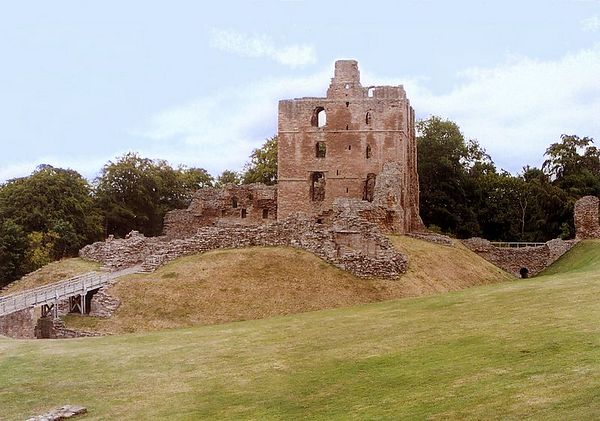
Heavily damaged keep of Norham Castle
In 1400, on some unknown occasion, Robert Ogle had been made prisoner by the Scots. In February 1402/3 he was appointed by the Bishop of Durham constable of Norham Castle, and justice, seneschal, sheriff and escheator in Norhamshire and Islandshire for 7 years; and in September for life.
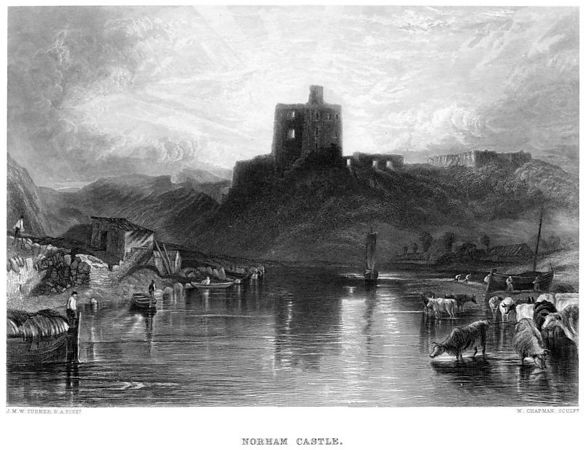
Norham Castle
He had the King’s writ for livery of his inheritance, 3, and livery 12 May 1410, being then a knight (d1). In May 1410 he was one of the commissioners to treat of a truce with Scotland, and in July commissioner of array in Northumberland. Sheriff of Northumberland, 1417-18, and Knight of the Shire, 1419-21, 1425 and 1435- In 1419 he recaptured Wark from William de Haliburton. In 1422 and succeeding years he was a commissioner of the peace. He was lieutenant of the Duke of Bedford as captain of Berwick Castle in 1423; and in the following year one of the escort appointed to conduct the King of Scots from Durham to Scotland. From 1425 to 1435 he was warden of Roxburgh Castle; in 1426 was one of the commissioners in Northumberland to arrange a short-term loan to the King; and in 1435 sheriff of Hexhamshire. He married, on or before 21 May 1399, Maud, daughter of Thomas GREY, lord of Wark. He died 12 or 13 August 1436 (d2). His widow was living 22 August 1451 (e). [Complete Peerage X28-9, (transcribed by Dave Utzinger)] It is written that as constable of Norham, he received a stipend of 2000 pounds, out of which, however, he had to pay for the upkeep of the soldiers who were based at Norham.
A marriage having been arranged between Robert Harbottle and his daughter, Margery Harbottle, he, as Robert Ogle, knight, lord of Ellingham, on August 20, 1424, settled land in Ellingharn on Robert Harbottle and his wife, Margery, and their heirs for the annual service of presenting a rose, but if no heirs by Margery then forty pence at the feasts of Pentecost and St. Martin, the trustees executing a deed on the 24th of August. These deeds being signed by Sir Thomas Grey of Horton and others. The same year the English made an inroad into Scotland. He was knight of the shire in the year 1425 and paid 116 shillings and 8d. for his relief for the manor of Hepple and the manor of Lowick. On April 4, 1426, he put the safeguard of the castle of Berwick into the hands of Sir William Swinburne to keep safely the Percy tower until the feast of All Hallows next, for which Sir Robert was to pay £25.309.
In 1427, Thomas Denum granted him the manor of Unthank, Rahegh Wood, near Middleton, and with lands in Chilcroft within the fields of Belford and Yesington. In 1429 he had a grant of free warren in Hepple, and in that year and in 1434, with his son, was a commissioner for the correction of violations of the truce. He was still at Roxburgh as Sir Robert Ogle, senior, in 1434. On May 1, 1435, he gave his son John the manor of Unthank and tenements in Howtell and Mindrum. On August 23, 1435, cardinal Langley appointed Robert Ogle constable of Norham for 20 years.
The charter appointing him is interesting. The lessee undertook the duties in times of peace, truce or war, he was to be constable, seneschal, sheriff, escheator, etc., to render the yearly rents of three demesnes belonging to the castle, with other sums, etc., he was to provide bed and board for the bishop’s receiver, his valet and two chevaliers and for their trenchman and other servants, for which he was to get 300 marks a year. Sir John Bertram was one of those who entered into a bond of £1,000 for the due performance of covenants. His name occurs on the 7th of December of the same year as sheriff of the counties of Norham and Hexham.
Robert Ogle died on August 12, 1436. His inquisitions were taken at Durham on the 20th of September and in Newcastle on October 8, 1436.
He held Netherton, and also Camboise and Choppington held of the earl of Westmoreland, the manor of Hepple, most of his land being wasted by the Scots, manors and lands in Tossan, Fallowlees, Netherwhite [Low Trewhit?], Flotterton, Warton, Trewhit, Ogle, Twisell, Shilvington, Aldworth, Saltwick, Seaton, South Disington, Blackheddon, Callerton, Thirnam, Fowberry, Ingram, Eland, Tyrwhite, Horsley, Denum, Bamburgh, Newhall, St. Mary Hill, Stanley, Clifton, East and West Hartington, Fairnley, Heugh, Dalton, Unthank, Mindrum, Whalton, Newham, Morpeth. His son was aged thirty years.
New Account To Robert Bertram, heir of the manor of Bothal, and to Gerard de Woderyngton, the king, at Newcastle, on the 25th of November, 1335, gave authority to raise and array the whole disposable force of the Morpeth ward of Northumberland, and to imprison all who disobeyed their orders. In 1343, this Robert obtained the king’s license to fortify his manor-house of Bothal with crenelles; or in other words, to fortify and convert it into a castle. He filled many public offices of eminence during the reign of Edward III., and fought with bravery in the battle of Nevil’s Cross, in which he captured William Douglas, and Malcolm Earl of Wigton, the latter of whom he was commanded by the king to convey to the Tower of London; but the Earl having escaped, the king empowered Sir Henry de Percy and Sir Ralph de Nevil to arrest the Baron of Bothal himself, and attach all his lands and goods. These were restored to him in the following year, and an annuity of two hundred marks out of the customs of Newcastle was granted to him, for his good services in the capture of Douglas. He died in 1363, leaving only a daughter, Helen, upon whom his barony and possessions descended. The lady of Bothal married first, Robert de Ogle, and surviving him, lived to marry three other husbands. John, the grandson of Sir Robert and the Lady Helen, (probably the donor of the antient font of the church of S. John in Newcastle, which font was destroyed by the Scots,) took the surname and estates of his grandmother; and was lord of Bothal Castle in the beginning of the reign of Henry VI. With the great-grandson of this John Bertram, viz., Robert Ogle or Bertram, who died young, ended his issue male; whereupon the Bothal estates, by entail, became the property of the descendants of Sir Robert Ogle, knight, and Maud, daughter of Sir Robert Grey, of Horton. In the contests between the royal houses of York and Lancaster, Sir Robert Ogle, being a zealous partizan of the White Rose, was created Lord Ogle.
Sir Robert Ogle departed this life in the 15th Henry VI, leaving issue,* by his wife, Maud, daughter of Sir Thomas Grey, of Heton, by Alice Neville, his wife, who was daughter of Ralph Neville, 1st Earl of Westmoreland and Werke, by Catherine Mowbray, according to Collins, eight daughters, married to persons of the first rank in the county, and three sons, Robert (Sir), his successor; John (Sir); William (Sir), from whom one account derives the Ogles of Kirkley Co., Northumberland, and the Ogles of Worthy, in Hampshire, baronets.
* Dugdale enumerates his issue thus:—
Robert, his successor.
Margaret, m. to Sir Robert de Narbottle, Knt Anne, m. to Sir William Heron, Knt. Constance to Sir John Milfurd, Knt. Joane, to — Manors.
According to Plantagenet ancestry: a study in colonial and medieval families Robert’s children with Maud were as follows. A second wife Alice is not cited. Maud is cited as being alive in 1453/4 suggesting that there was no second wife. However, other sources suggest she had one daughter.
| Child |
Born |
Married |
Departed |
| Robert Ogle |
1406 |
Isabel Kirkby |
1469 |
| John Ogle |
|
|
|
| William Ogle |
abt. 1412 |
unknown name |
10 Aug 1474 |
| Margaret Ogle |
|
Robert Harbottle |
|
| Anne Ogle |
|
William Heron abt. 1411 |
|
| Constance Ogle |
|
John Mitford |
|
| Joan/Jane Ogle |
|
Robert Manners |
|
| unknown Ogle daughter |
|
John Lilburne |
|
| unknown Ogle daughter |
|
Thomas Lisle |
|
| unknown Ogle daughter |
|
Matthew Witfield |
|

Robert Ogle & Joan Heton Pedigree — Robert Ogle & Maud Grey
Robert Ogle died on August 12, 1436. Maud/Matilda Grey is mentioned on the 22nd of August, 29 Henry VI [1428] as holding Longwitton for life. In 1453/4 a Matilda Ogle, widow, held the tithes of Newbiggin.
Resources
A history of Northumberland, in three parts, Part 2, Volume 1
by John Hodgson, John Hodgson-Hinde
Descriptive and historical notices of some remarkable Northumbrian castles …
by William Sidney Gibson
A genealogical history of the dormant, abeyant, forfeited, and extinct …
By Sir Bernard Burke
Plantagenet ancestry: a study in colonial and medieval families
By Douglas Richardson, Kimball G. Everingham page 396
The English Ogle Genealogy
Genealogy of the descendants of the Prichards, formerly lords of Llanover …
By Thomas Gregory Smart


